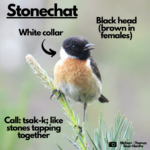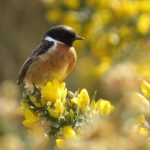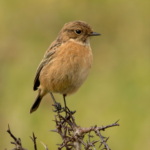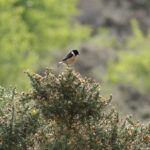Stonechat

Back Nightjar Dartford Warbler Woodlark Stonechat Linnet Tree Pipit
Stonechat
Saxicola rubicola
Stonechats are small birds – about the size of a Robin – that inhabit heaths, bogs and conifer plantations. The males look striking with a black head, white neck and orange-red breast with a mottled back. The females, not so vivid in appearance, being a mottled brown, with a dusky orange hue. They’re often seen sitting on top of gorse bushes flicking their wings and tail while making their distinctive call. The name comes from this call – some people say the sound is like two stones being tapped together.
Stonechats lay 5-6 light blue eggs, speckled with brown, in cup-shaped nests built on or near to the ground, sheltered by dense bush.
The scientific name Saxicola means “rock dweller” from the Latin for rock + incola, or “dwelling in”, and rubicola meaning “bramble-dweller”, rubus meaning bramble in Latin.
- Stonechat © Michael Jones
- Female stonechat
- Stonechat © Bryony Davison
[Click on the thumbnails to open]
Where/when to find them
Stonechats can be found all year round on heaths, bogs and commons, particularly with gorse, broken areas with hedges and embankments. They mainly breed in the western and southern parts of the UK, and often disperse to coastal and wetland areas during the winter.
Adaptations
Stonechats can often be seen in the same locations as Dartford Warblers. It’s thought that the smaller warblers eat the insects disturbed by the Stonechats. So, if you see a Stonechat look out for Dartford Warblers too!
Diet
Omnivores. They eat invertebrates, seeds and fruit such as blackberries.
Rarity
Stonechats are ‘green’ on the UK list of Birds of Conservation Concern.
Read more
Birding beginnings: Skittish Stonechats
On our blog: A nature-spotter’s dream
#MoreThanJustNightjars




